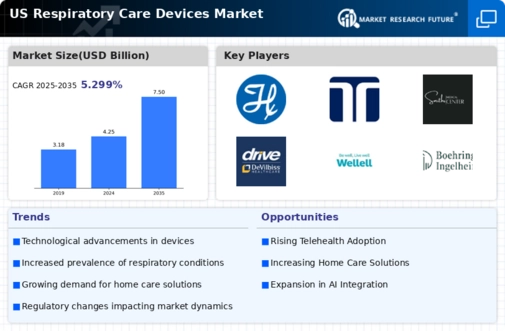Technological Innovations in Device Design
Technological advancements in the design and functionality of respiratory care devices are significantly influencing the market. Innovations such as portable nebulizers, smart inhalers, and advanced oxygen concentrators are enhancing patient compliance and treatment efficacy. The integration of digital health technologies, including mobile applications and telemedicine, allows for better monitoring and management of respiratory conditions. As a result, the respiratory care-devices market is experiencing a transformation, with an estimated market value projected to reach $30 billion by 2026. These innovations not only improve patient outcomes but also attract investments from healthcare providers and technology companies, further propelling market growth.
Increasing Prevalence of Respiratory Diseases
The rising incidence of respiratory diseases in the US is a primary driver for the respiratory care-devices market. Conditions such as asthma, chronic obstructive pulmonary disease (COPD), and other pulmonary disorders are becoming more prevalent, affecting millions of individuals. According to recent data, approximately 25 million Americans suffer from asthma, while COPD affects around 16 million. This growing patient population necessitates the demand for advanced respiratory care devices, including nebulizers, inhalers, and oxygen therapy equipment. As healthcare providers seek to improve patient outcomes, the respiratory care-devices market is likely to expand significantly, with an expected growth rate of around 7% annually over the next few years. This trend indicates a robust market potential driven by the need for effective management of respiratory conditions.
Rising Awareness and Education on Respiratory Health
There is a growing awareness and education regarding respiratory health among the US population, which is positively impacting the respiratory care-devices market. Public health campaigns and initiatives aimed at educating individuals about the importance of respiratory health and the management of chronic conditions are becoming more prevalent. This increased awareness is likely to lead to higher demand for respiratory care devices, as patients become more proactive in seeking treatment options. Furthermore, healthcare professionals are emphasizing the need for early diagnosis and intervention, which could result in a projected market growth of approximately 6% over the next five years. The respiratory care-devices market stands to benefit from this heightened focus on health education.
Aging Population and Increased Healthcare Expenditure
The demographic shift towards an aging population in the US is contributing to the growth of the respiratory care-devices market. Older adults are more susceptible to respiratory ailments, leading to a higher demand for respiratory care solutions. By 2030, it is projected that nearly 20% of the US population will be aged 65 and older, which correlates with increased healthcare expenditure. The Centers for Medicare & Medicaid Services (CMS) indicates that national health spending is expected to grow at an average rate of 5.4% annually, reaching approximately $6 trillion by 2027. This increase in healthcare spending is likely to enhance access to respiratory care devices, thereby driving market growth as healthcare systems invest in advanced technologies to cater to the needs of the elderly.
Government Initiatives and Funding for Respiratory Care
Government initiatives and funding aimed at improving respiratory care services are driving the growth of the respiratory care-devices market. Various federal and state programs are being implemented to enhance access to respiratory care, particularly for underserved populations. The US government has allocated substantial resources to support research and development in respiratory health, which is likely to lead to the introduction of innovative devices. Additionally, reimbursement policies are evolving to cover a wider range of respiratory care devices, making them more accessible to patients. This supportive regulatory environment is expected to foster market growth, with an estimated increase in market size of around 5% annually as new devices enter the market.






















Leave a Comment